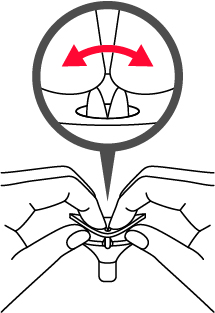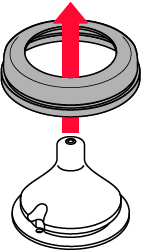
operating instructions:
Multi-fit wide mouth type baby bottle/nipple
【Shipping】
・Heat-resistant glass baby bottle 240mL
・Heat-resistant glass baby bottle 160mL
・Plastic baby bottle 240mL
・Plastic baby bottle 160mL
・Silicone rubber nipple 1 piece ・Silicone rubber nipple 2 pieces ・Slow drinking nipple 1 piece
Part name
 hood
hood
 nipple
nipple
![]() cap
cap
 bottle
bottle
Please use the special hood and cap for multi-fit wide mouth type nipples.
●The parts are not compatible with the old wide-mouth type series, so please do not use them together. If used in combination, the hood may come off or the contents may leak.
●The baby bottle body can be used regardless of the compatibility of the parts.
●Please use baby bottles and nipples from the same manufacturer.
●Slim type nipples cannot be used.
● Please check the bottom of the page for information on how to distinguish between parts .
Please read this manual before use. Also, please save it using the bookmark function until you finish using it.
Handling precautions
●Do not use for any other purpose.
●Children/babies should not have a bottle; parents should always breastfeed the child. (This may lead to unexpected accidents.)
●Do not use if there is damage, cracks, chips, etc. Also check before use.
●Be careful not to drop it from a high place or subject it to sudden impacts or temperature changes as it may be damaged.
●Do not store within reach of children.
●Store in a clean, dry place away from fire and direct sunlight. (Be especially careful with plastic baby bottles as they may soften or change.)
●Do not heat directly in the microwave.
About heat-resistant glass baby bottles
●Heat-resistant glass baby bottles are fragile.
●There is a risk of damage if dropped, sudden impact, or temperature changes.
●When it breaks, pieces may fly off, the bottom may fall out, or you may be injured by sharp pieces.
●Before each use, check for damage, cracks, chips, etc. (especially screws), and if any are found, never use the product.
●Do not prepare milk near your child or allow your child to hold a bottle.
●The scratch-like marks on the bottom are called "shear marks" and are caused during manufacturing. Please use with confidence.
About plastic (PPSU) baby bottles
●Plastic (PPSU) baby bottles are made of a material that does not contain bisphenol A, which is one of the endocrine disrupting chemicals (endocrine disruptors) that are said to affect the human body. It can be safely used even for newborns.
●The light brown color of the bottle itself is the color of the plastic (PPSU) material.
●The dent at the bottom is a result of manufacturing. Please use with confidence.
●If you polish with a hard brush, it may get scratched and become opaque, so please use a soft sponge brush.
*PPSU (polyphenylsulfone)
About silicone nipples
●The nipples are coated with a safe oil-based protectant made from food additives to protect them. Please be sure to clean and disinfect before use.
●Be sure to clean the air valve before use.
●Do not use damaged nipples. Also, please be aware that the nipple may tear if your baby has teeth.
●Silicone rubber has the property of adsorbing surrounding pigments, moisture, and odors. Please be careful about the storage location.
●"Slow Drinking Nipple (1 piece)" has a suction hole that is less open (compared to our company), and is a nipple that supports slow drinking for those who suffer from problems such as drinking too fast or milk overflowing from the mouth.
When to replace nipples
●Tutu's nipples do not need to be resized due to age, but they will deteriorate with use, so please replace them regularly.
●Estimated replacement time is approximately 1 month, using 2 to 3 nipples alternately. In this case, we recommend replacing them one at a time, rather than replacing them all at once. (If you use one nipple continuously, you may get used to it and dislike other nipples.) Also, if you find any cracks, please replace it regardless of the period.
Other notes
●Please use baby bottles and nipples from the same manufacturer. This may cause milk to leak or crack.
About cleaning and disinfection
●Please clean and disinfect the product before using it for the first time and after each use.
●Do not use sterilizers, dishwashers, dryers, or ultraviolet sterilizers that reach high temperatures.
●Remove each part and clean and disinfect.
●If the nipple turns inside out during cleaning or disinfection, please put it back in place.
<Precautions when cleaning>
●The milk components become difficult to remove over time, so please wash them carefully using baby bottle detergent immediately after breastfeeding.
●When cleaning, please use a brush made of material suitable for each baby bottle.
・Glass baby bottle: Nylon (sponge) brush ・Plastic baby bottle: Sponge brush (soft material)
・Nipples: nipple brush, etc. (lightly massage and wash the suction hole and air valve)
<Precautions when disinfecting>
●When disinfecting, please disinfect all parts at the same time.
●Be careful of burns when sterilizing by boiling. Please be especially careful when children are nearby.
●For chemical disinfection, please follow the handling instructions. Please note that silicone rubber products will turn milky white if left soaked for a long time. The recommended soaking time is 1 hour.
●When disinfecting in the microwave, be sure to use a container specifically designed for microwave disinfection and follow the handling instructions. Do not microwave directly.
●Before disinfecting, be sure to wash to remove milk stains and detergent solution.
Disinfection methods and precautions
*Please leave all parts of the washed baby bottle removed.
<Boiling disinfection>
Place the baby bottle parts (hood, nipple, cap, bottle) into plenty of boiling water and boil for 3 to 5 minutes. Please be careful not to touch the edges of the pot, etc. as this may cause deformation.
 Disinfector (pot)
Disinfector (pot)
<Medical disinfection>
Please follow the manufacturer's instructions using medicines and medicines for baby supplies such as "Just put on the tutu".
<Microwave disinfection>
Be sure to use a container specifically designed for microwave sterilization and follow the handling instructions. Do not heat directly in the microwave.
<Disinfection method>
| Part name | boiling | Chemical solution | microwave oven | Heatproof temperature |
| glass baby bottle | ○ | ○ | ○ | - |
| plastic baby bottle | ○ | ○ | ○ | -20~180℃ |
| nipple | ○ | ○ | ○ | 120℃ |
| hood cap | ○ | ○ | ○ | 120℃ |
How to care for your nipples
●When using for the first time and after each use, please clean and disinfect with detergent for baby bottles.
●Be sure to clean the air valve before use. If you look at it from the back and gently spread the air valve (the hemispherical part) to both sides with clean fingers, air will enter smoothly.

How to set the nipple and bottle
① Pass the nipple through the bottom of the cap.

②Pull up and down several times to set the nipple so that the bulge appears clearly. (Repeat firmly several times)

Make sure that the red circle (dotted line) part comes out from the cap.

With the cap facing backwards, check that the base of the nipple is a uniform circular shape without twisting or sagging.
③ Tighten carefully so that it does not fit diagonally, and set it securely in the baby bottle.

Preparation methods and precautions
●Please follow the handling instructions for each powdered milk for the preparation method.
●Please be careful of burns from boiling water or hot baby bottles. In particular, avoid formulating milk near children as it can be dangerous.
●For milk preparation, use hot water that has been brought to a boil and then adjusted to a temperature of 70℃ or higher. Please avoid pouring boiling water immediately after boiling, as there is a risk of burns or damage.
●Set the nipple and cap with the air valve cleaned into the baby bottle, and stir in a circular motion on the bottom, never shaking vertically. If you shake it vertically, there is a risk that the milk will squirt out due to the internal pressure, so it is safe to do something to let the air escape, such as loosening the cap. It is also safer to attach the hood.
●After preparing milk, please adjust the temperature to the appropriate temperature by placing it under running water, etc. The ideal temperature for breastfeeding is human skin temperature (approximately 40℃). At that time, please avoid cooling it all at once with cold water to prevent cracks and damage. Immediately after placing it under running water, only the surface of the bottle may be cool. Stir in a circular motion, then place the baby bottle against your skin to check the appropriate temperature.
●The scale displayed on the baby bottle is a guideline for formulating milk. (If precision is required, please use a measuring cup or spoon)
Please use the special hood and cap for multi-fit wide mouth type nipples.
●The parts are not compatible with the old wide-mouth type series, so please do not use them together. If used in combination, the hood may come off or the contents may leak.
●The baby bottle body can be used regardless of the compatibility of the parts.
●Please use baby bottles and nipples from the same manufacturer.
●Slim type nipples cannot be used.
| How to identify parts | ||
| Old wide mouth type series (Manufactured before February 2023) | New multi-fit wide mouth type series | |
| nipple | -The pedestal (shaded area) has the engraving shown below.  ●Short tip  | -The pedestal (shaded area) has the engraving shown below. The numbers are 2-1 and 2-2.  The numbers are 1-1 and 1-2. ( slow nipple drinking) The numbers are 1-1 and 1-2. ( slow nipple drinking)●Long tip  |
| hood | ●Color options: blue/pink  -There is a protrusion at the top of the inside  | ●Color options: green/beige  ●No protrusion at the top of the inside  |
| cap | *The old and new caps are very similar in shape, but they are different. | |
| ●Rib on the back (hatched part) is vertical  Cross section | -The ribs on the back (hatched area) are diagonal  Cross section | |
 GEX Co., Ltd.
GEX Co., Ltd.
2-3-12 Tanimachi, Chuo-ku, Osaka 540-0012 Customer Service Center ☎06-6942-4416 (9:30-17:00, excluding Saturdays, Sundays, and holidays)
Chuchu homepage https://chuchubaby.jp
